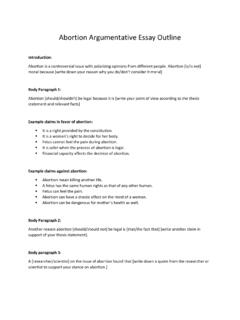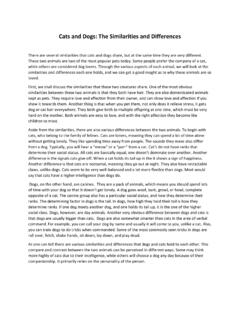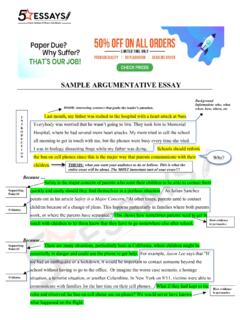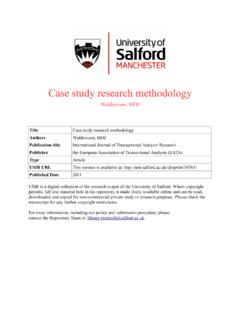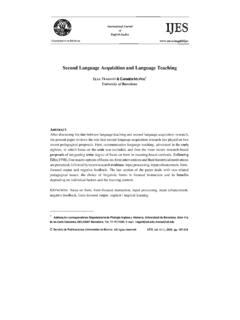Transcription of Research Proposal Example - Essay Writing Service
1 APA Style 1 Running head: APA STYLE: AN Example OUTLINE OF A FULL Research APA Style: An Example Outline of a Full Research Paper Your Name Lewis-Clark State College (TITLE: Must be specific and concise [20 word limit]. Must include variables. Must include mention of population. Do not use jargon. ) APA Style 2 Abstract (This is your section header centered on the page) Type your abstract here within APA abstract limits (100-250 words) For a Proposal , here, you will state the purpose of your study, the population you are studied, the sample you used, and your method: qualitative or quantitative, instrument (interview, survey, questionnaire, etc.)
2 For a complete paper you would add your summarized findings. APA Style 3 Your title (Your title is your section header centered on the page) You will need to bring all your written communication skills to this project. You will be very careful with proper citation. You will not use direct quotes. The whole of this paper is to be in your words. Ideas and information used from other authors are to be cited. Introduction (2-3 pages) First address the problem! State the overall area of concern (populations-at-risk for injustice or discrimination; need for more functional affiliations for individuals and groups; unethical policies/practices; lack of knowledge in the field, etc.)
3 Arouse the reader s interest; tell the reader what to expect in the rest of your paper. Provide brief statistics to indicate the incidence of the problem. Next, answer the questions, How does this problem effect social work practice and/or policy? (Ethical Research requires us to focus our efforts where need is the greatest). The potential utility of your study can be: 1) an addition to current knowledge of a problem or a vulnerable population; 2) to put social work theory to an empirical test; 3) to better understand the relationship between variables (like homelessness and housing shortage); or 4) to determine the effectiveness of a treatment method or program.
4 Discuss how this problem area affects individuals, communities, and society as a whole (what are issues of social and economic justice). Refer to your Problem Statement Outline. Variables Conceptually define your major variables in a clear and concise manner, child abuse or domestic violence . Remember the puzzle exercise. Summary Summarize this chapter in approximately two to three paragraphs. (Add any additional points or sub-points that relate to your study) APA Style 4 Review of the Literature (5-7 pages) (This is your section header centered on the page) Type your literature review here, double spaced, and cite in APA style throughout Brief history It is helpful to your readers to understand the context of your problem and the solutions that have been attempted to date.
5 Is this a recent problem? An on-going one? What brought it to the attention of the public? Review You need to summarize what existing literature has to say about your problem and the existing solutions: What has been tried, what has worked, what has not worked, why. As you begin, you need to share your theory base with the readers so they understand how what you are presenting is influenced by that theory base. As you read articles on your topic look for what other authors have to say about a theoretical framework for understand the problem and pointing a direction for solutions (refer back to your Micro Skills text for theories).
6 This section should flow from past to present. What where the earliest interventions or solutions? What are the most recent? Be sure to present all sides whether or not they agree with your hypothesis. Your Research will typically involve some gap in information (why Research what we already know?). After you present what is already known, make your case for your Research either answering a new question, getting a new answer to an old question, answering a question about a new population, etc. After you have made your case that your Research is going to give new information, you will summarize the major points.
7 Finally, you will formulate (in the last sentence) your Research question or your hypothesis. Remember that the Introduction discusses the problem. The review of literature should concentrate on solutions (those that exist, those that are still required). APA Style 5 Method ( 3-5 Pages) (This is your section header centered on the page) Purpose (This is your sub-section header, italicized, left justified) Do not introduce the topic again. Introduce the general methodology most authors have taken on this topic and the one you will be using and why (tie to the literature review).
8 The purpose is a statement of what you intend to study not what you intend to find. Paradigm Here, you will discuss your philosophical paradigm for the acquisition of knowledge (see Paradigm handout). Again your reader is entitled to understand how you view reality. This will greatly influence how you frame the problem, the solutions, and how you will know you have learned something from your results. Not everyone shares the same paradigm so it is only ethical that you describe yours with your reader. Although you will rarely find this information in published works, you will use this exercise to understand your own philosophy on knowledge acquisition and be able to articulate it.
9 Study Design This should flow from your paradigm. Are you doing qualitative or quantitative; is it exploratory, descriptive or explanatory? Explain why you are using this type of study and what you plan to explore, describe, or explain (again tie it to the literature review). Within either design: quantitative or qualitative, tell the reader what type of study is being used: is it ethnographic, content analysis of written material, interview, or a program evaluation, Why is this design best for your study? (continue tying it to the literature review).
10 Population and Sample What is the population you plan to study ( , all the social worker students in Idaho), what is your sampling plan ( , convenience, stratified, random), and why? (that s right - tie it to the literature review). Give as much information about the population that has been gathered from your review of the literature: age range, gender mix, education, etc. This will be used to compare to your sample s demographics in the Results section. Investigative Techniques Do you plan to use interviews, behavior observation, questionnaires, What subtype of each do you plan to employ ( , structured vs.)





